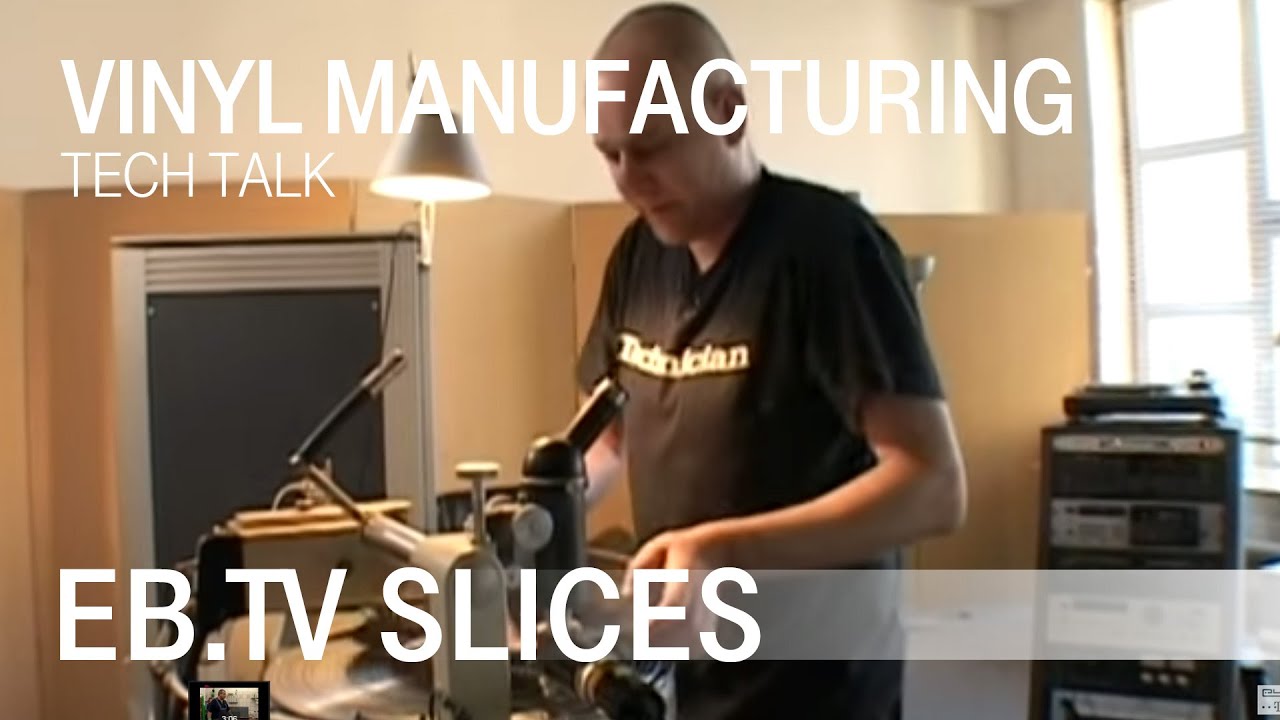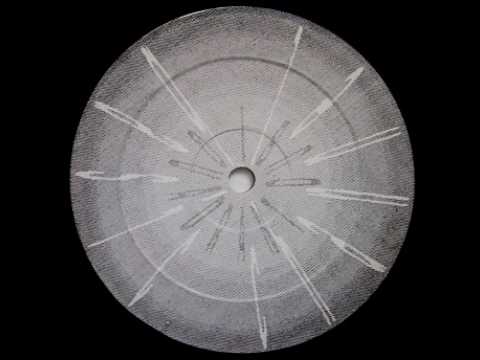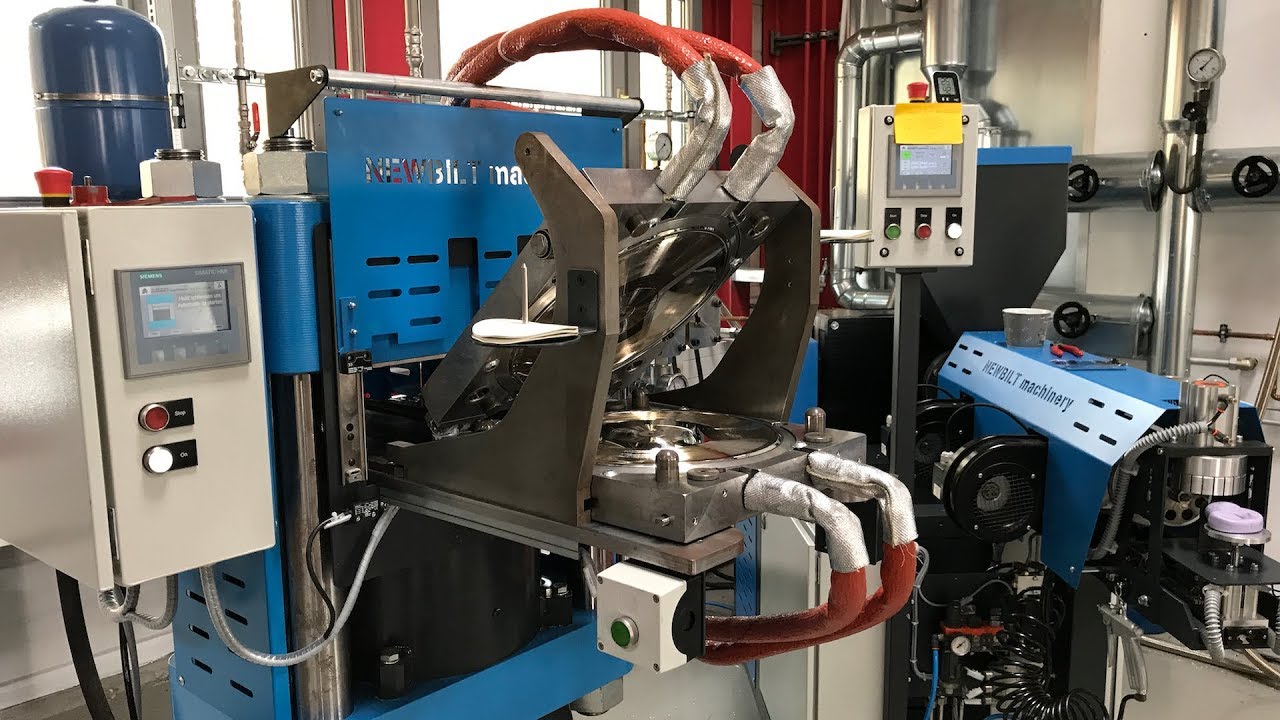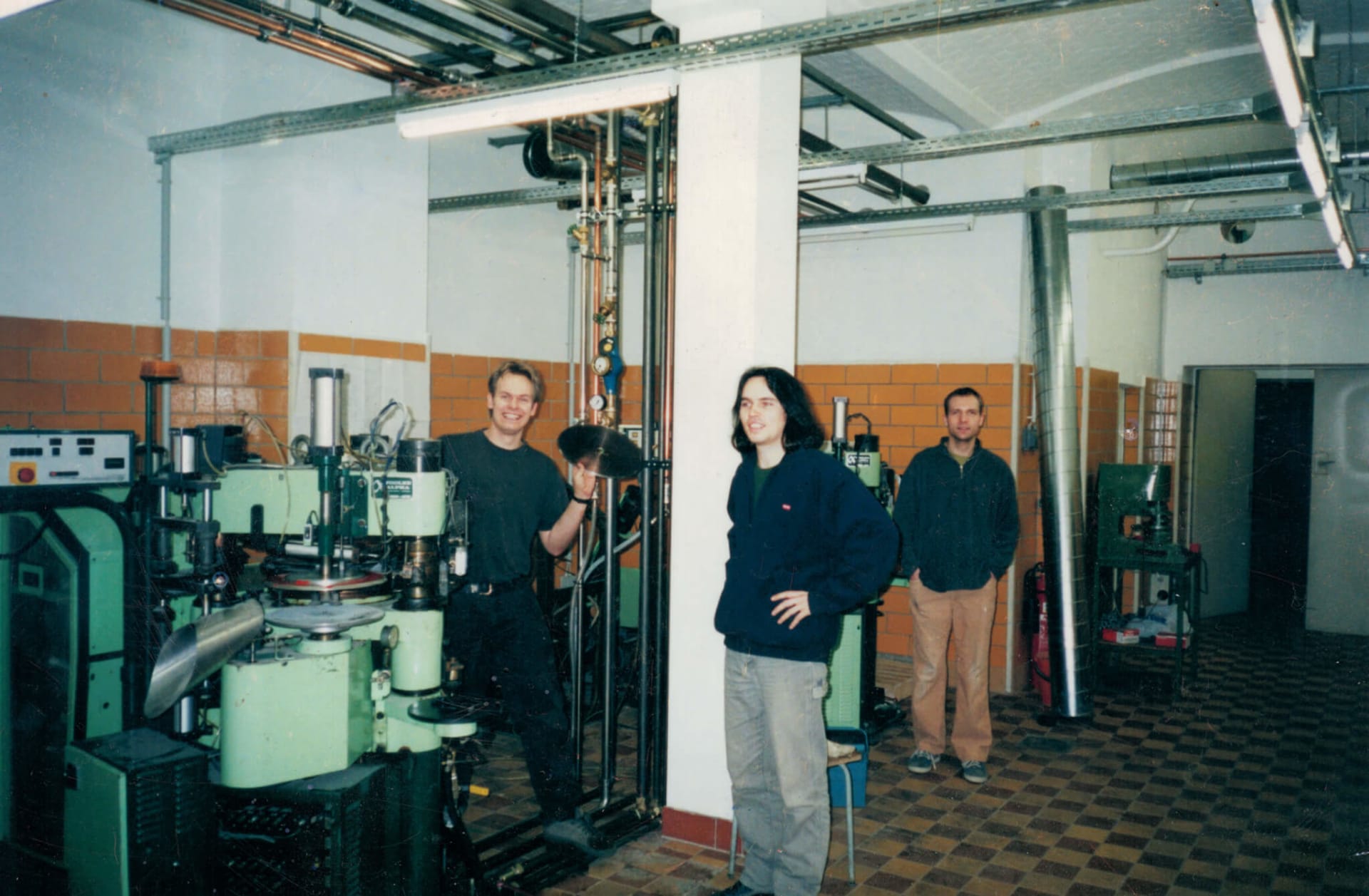
The Vinyl Manufacturing Studios That Democratized Club Music
Do it yourself: three words that have informed music subcultures since the punk explosion in the 1970s. And electronic dance music is no exception. The different histories of its many sub-genres contain a common thread in the democratization of the means to produce, release and distribute music via technological developments. In Germany, the DIY philosophy and ethos fuelled two Berliners’ efforts to start their own mastering and vinyl cutting studio called Dubplates & Mastering in 1995, and the same can be said for the three fresh-faced youngsters who decided to try their hand at cutting and manufacturing vinyl in their home town of Leipzig as R.A.N.D. Muzik.
In this case, DIY doesn’t refer to amateurism, but rather to obtaining and distributing the professional tools necessary to elevate an emerging underground scene. In that sense, the people involved acted out of necessity, as mastering and cutting vinyl records was still mostly done by major labels or their affiliated cutting studios, which didn’t cater to the special needs of a house or techno track. In the US, some highly paid independent mastering engineers evolved from mere technicians to stars in their own right, and their name on a record could move units. No such figure yet existed in Germany, but the stage was set for ambitious entrepreneurs to change the game. The advent of digital equipment in the ‘80s made analog music production gear affordable, and shortly after that, the CD drove down prices of the machines used to cut and press vinyl. Still, the titans of the mainstream music industry considered vinyl a dying medium.
Of course, things look very different today, after a well-documented vinyl renaissance resulted in increased demand for wax. The boom placed more pressure on the industry’s existing infrastructure—especially pressing plants, which are harder and more expensive to establish than mastering studios. The effects have trickled down to underground dance music, where a number of competitors to Dubplates & Mastering have entered the market but R.A.N.D. remains one of the few plants to serve a growing number of record labels. The 1995 opening of D&M and, in 1997, R.A.N.D., marked important steps in Germany’s techno community taking full control of the whole process of vinyl manufacturing and laid the groundwork for the independent and highly specialized industry that currently exists.
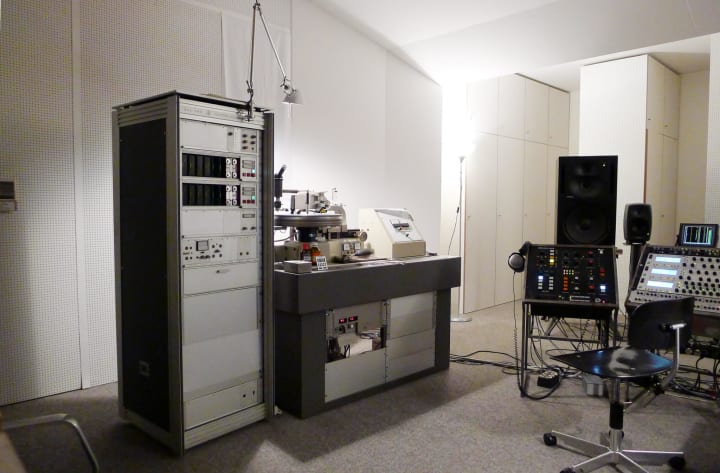
PART ONE: DUBPLATES & MASTERING
Today, mastering a dance record before it gets released is a given in the course of creating it—and that was not always the case. The process involves balancing a track’s frequencies (bass, mid-range and highs) to make sure it sounds as good as possible across various formats, and an engineer’s job is thus to make sure that the balance of sounds won’t cause the record to skip or sound distorted when played on vinyl. While German dance music creators in the early ‘90s weren’t aware or didn’t concern themselves with the possibilities of mastering, many studios now specialize in working specifically with club genres and are run by producers or former producers themselves. Some of them—like Dubplates & Mastering, Man Made Mastering or Scape Mastering—also offer cutting services, which means they use a machine called a lathe to carving the music onto an original disc that will be duplicated at a pressing plant.
Although it may sound like a technical procedure, optimizing a track can also be a creative pursuit that requires artistic decisions. Still, that’s not how it was perceived in Germany in the mid-‘90s. “At the time, there was hardly any awareness of the crucial importance and the potential of the vinyl cut in Germany—at least not in the techno scene,” Dubplates & Mastering co-founder Mark Ernestus explained over a cup of tea in his studio. Between 1989 and 1995 it housed the first incarnation of now-famous techno record store Hard Wax, which Ernestus founded. “In the US and the UK you already had mastering and cutting legends—also for club music—whereas in Germany it was commonly seen as an engineer’s job, referred to as ‘transfer’ from one medium to another with no regard for creative aspects. We always envisioned elderly men in grey lab coats doing it.” Back then, he said, engineers used the terms “mastering” and “cutting” interchangeably to describe two very different steps: the first refers to the practice of adjusting and optimizing a track’s frequencies, volume levels and stereo-image, while the second describes the act of making the initial master of a record that will be sent to a pressing plant to be copied. Since it was done in the serious and rather conservative spirit of German engineering, strict industry standards—especially regarding levels—further limited the ability to cater to club music.
“The whole approach was very different,” agreed Christoph Grote-Beverborg (AKA CGB-1), who joined Dubplates & Mastering in 1996 and has owned the company since Ernestus and Moritz von Oswald sold their shares in 2001. “The engineers were walking around in white work coats with name tags on them.”
D&M transformed not only the work environment of mastering studios, but the actual process of mastering and cutting as well. While the major label’s engineers’ attention was mostly focused on the technical concerns of making sure a record could physically be cut to vinyl without sounding distorted, the guys at D&M tailored their approach to a genre that was foreign to the old guard—electronic club music—and maximizing its impact. The traditional method of mastering mostly focused on technical treatments informed by the requirements of the medium vinyl and the mechanics of the cutting lathe, as some frequencies cannot be cut onto wax without causing the needle to skip.
That said, most cutting machines were over-engineered for the demands of rock, pop and classical music and equipped with massive headroom regarding potential cutting levels. According to Grote-Beverborg, that eventually came in handy for club music’s different needs and adjusted mastering treatments, as the aim is to cut the music in such a way that it will play loudly without harming the sound quality.
Cutting lathes were extremely expensive in the 1970s and ‘80s. The Neumann VMS70, the machine that still stands at Dubplates & Mastering, cost 320,000 Deutschmark in the 1970s, which was equivalent to two single-family homes. Such a prohibitive cost prevented newcomers from entering the market and challenging its domination by major labels. For instance, Grote-Beverborg cited Boney M and Milli Vanilli producer Frank Farian as a rare independent owner of the VMS80, an updated and even more expensive model of the Neumann cutting lathe. Whenever he made a mixdown of a new track, he cut a dubplate for himself to check how it sounded on vinyl. Once he was happy with the result, he sent the premaster off to his label for cutting and pressing.
Grote-Beverborg also pointed out that the democratization of music-making, enabled by the advent of MIDI, changed the industry. “In the mid-‘70s, punk, industrial or new wave bands like Throbbing Gristle or Cabaret Voltaire didn’t really have the money for mastering, but it didn’t really matter. Their records were lo-fi, but that was part of the whole aesthetic and philosophy. It wasn’t ‘functional’ music, after all,” he said, referring to the idea of functionality on a club sound system.
Disco was the first music to be “functional” in that sense, but most of the ‘70s disco records—especially in America—were still produced in big studios by experienced professionals with a keen knowledge of the medium vinyl. Unsurprisingly, the first 12-inch single was a disco record, as the new format had a shorter running time compared to regular albums. That allowed the engineer to cut the music at louder levels, which means the grooves are wider. All this made the 12-inch perfectly suited for club play. “When bedroom producers started to make dance music, their productions had to meet the demands of a loud club sound system, and that is where things really changed—and Germany was a bit late in the game,” said Grote-Beverborg.
“Back in the mid-‘90s there was an ongoing conversation in Germany’s electronic music community about the necessity of having a closer look at the creative possibilities of mastering and to acquire the know-how to do it yourself,” said Andy Mellwig, one-half of the recently resurfaced experimental dub techno duo Porter Ricks. He became Dubplates & Mastering’s first employee after working as a sound designer in Dortmund and releasing a solo album on von Oswald’s label, Imbalance Recordings.
The final seed of inspiration to take action was planted during a trip to Detroit, Ernestus explained. A visit to the late Ron Murphy’s mastering and cutting studio National Sound Corporation changed everything for him. Murphy had garnered international renown for playing an integral role in shaping the sound of Detroit techno. He taught the genre’s pioneers-in-the-making—Juan Atkins, Derrick May and Kevin Saunderson—how to achieve better mix-downs of their raw productions and then mastered and cut them in such a way that would make them shine.
Over time, National Sound Corporation became synonymous with Detroit house and techno, and the letters NSC etched into a record’s run-out groove became a seal of quality that endowed a mythical aura both cherished and fetishized. So, when Ernestus made a pilgrimage to the Motor City in 1991 with the mission of buying records from local labels that he could then stock at Hard Wax, Underground Resistance’s Mike Banks took him to Murphy.
“It was a real aha experience,” remembered Ernestus. “It made a lasting impression on me—the whole process suddenly was really tangible. There was the 1936-built Scully cutting lathe at NSC with Ron’s hands-on approach, but also Archer Record Pressing right in the city. You drove over to NSC and gave Ron the DAT cassette with your tracks. Then he listened to everything on his banged-up speakers, cuss you out for what you screwed up in the mix, make some corrections and cut it. Then he’d send the lacquers to the plating service and have the stampers sent to Archer’s, and a couple days later you could listen to a finished copy on a crappy record player and load the boxed records into your trunk. You could witness the whole process in real time.”
This highlighted to Ernestus how unnecessarily complicated pressing records was in Germany and how the antiquated methods counteracted producers’ efforts to make functional club tracks. “Back in Berlin at that time, all the labels we knew around Hard Wax simply sent their DATs to the pressing plant, let them do their thing and not worry about it,” he said.
“Mark and Moritz were in awe of Ron Murphy,” remembered Mellwig. “His approach and way of working was very different to how things were usually done in Germany. Ron’s cuts were our orientation when we started D&M. We analyzed his levels and his frequency response characteristics. We soon realized that the common German industry standards were actually a restriction for the possibilities and that there was a lot more to be done and to explore in terms of sound design and volume. So we started to investigate. The general idea was to adapt the Detroit sound. That was the bar we aspired to, which made complete sense to me back then. We were definitely the first in Germany to expand the idea what mastering can do.”
Despite their enthusiasm, it took Ernestus and von Oswald four years to finally start D&M. In that time, they mastered and cut a now-legendary series of records as Basic Channel and Maurizio through Murphy in Detroit and Herb Powers in New York. Their groundbreaking work in fusing dub aesthetics and techno gained a clandestine allure thanks to their reputation for guarding their music with secrecy—so starting their own mastering and vinyl-cutting endeavor made perfect sense for these fiercely independent artists.
After doing some research, the pair found a man willing to sell his late father’s Neumann VMS70 cutting lathe. “He could only show us how to make a very basic cut, but of course we were more tech-interested and keen to push the limits. With that knowledge, we started our little research project. So it was just the beginning of a long and at times steep learning curve,” said Ernestus.
Ernestus and von Oswald were certain that acquiring and building the expertise and infrastructure for DIY vinyl manufacturing would be a fruitful endeavor. “Of course we were naïve in many aspects, but one thing was clear to us before we started: buying, learning and maintaining a cutting machine and mastering equipment would not be sustainable if we just cut our own output of a few records a year,” Ernestus said. They decided to justify the expenses by making a business around mastering and cutting records for many producers—not just themselves. “We knew we had to run it as a service and that would be a demanding business in and of itself, so we’d need someone to be in charge of it full-time,” said Ernestus.
That person was, of course, Andy Mellwig, who Ernestus referred to as “the heart of D&M” during its nascent years. While Mellwig dealt with the business demands from outside clients, he and Moritz learned to work the machinery primarily in order to have as much control over their own sound as possible.
According to Mellwig, D&M’s customer base and methods evolved rapidly—especially because Hard Wax provided them with a built-in networking platform. “Thanks to the shop, word spread really quickly,” Mellwig said. “Having the option to cut a dubplate from your own unreleased tracks to test in the club was also a huge costumer-driver. A lot of producers made use of this service.”
Within months, D&M became an established name in the techno underground. They met the dire need for mastering engineers who knew how to make even a mediocre techno track shine, how to cut it to vinyl and—most importantly—who understood techno’s artistic conventions. Amateur musicians seeked their assistance in achieving the proper sound for club systems, which meant that Dubplates & Mastering helped to democratize the abstruse techniques of mixing and mastering. Today, it’s common practice for even the most hermitic bedroom producer to mix down productions in a way that leaves room for the engineer to improve upon their work.
“We can ‘save’ a bad-sounding mix or give an already good production a little extra kick,” Grote-Beverborg said. “Our customers often don’t expect that the final master sounds exactly like the pre-master they gave us. They trust us to get the best results for them, and that trust endows us with a lot of liberties when treating the music we are given.”
But it wasn’t just access to mastering and cutting studios that specialized in producing house and techno records that made mastering more important in the ‘90s; records also became louder across all genres, and that posed new challenges for engineers because high volumes can cause distortion. “In the beginning, our customers’ most common demand was volume: ‘How loud can you cut my tracks?’” Ernestus said. “So in most cases we had to treat the material, which had often not been mixed professionally, in order to then try to achieve the maximum physically possible on the medium—regardless of the DIN standard,” said Ernestus.
Grote-Beverborg pointed out that dance music’s aesthetics, advanced mastering techniques and the creation of the 12-inch single made music louder and louder over the decades. “A ‘60s jazz record is to a jungle record as an upright bass is to a Fender Precision electric bass with two stacks of amps,” he joked. “Ultimately, I think it’s best if mastering and cutting are done by the same person. That was always our claim, even though we never advertised it. I think of what we do not so much in terms of doing something creative or artistic, but something very pragmatic. One of my goals with functional music like house and techno has always been to be able to play them as loud as possible without hurting your ears.”
Hard Wax and D&M’s combination of success and secrecy—its proprietors never gave endeavors or promoted themselves—proved fertile breeding ground for urban legends. “Once we heard someone say that if you send a record to D&M for mastering, the three Basic Channel members would sit down and listen to it carefully. If they liked what they heard, they would do a really good job. But if they didn’t, they’d fuck up and mess with the sound,” Grote-Beverborg said with a wry smile. By the end of the ‘90s, Dubplates & Mastering had acquired a mythical, quasi-religious aura, and the associated engineers were slowly but surely seen as artists in their own right. For many producers and label heads, a cut at D&M connected their record to its legacy and much sought-after authenticity.
However, not everyone bought into the admiration and hype—especially in Germany and especially at first. “In the ‘90s there was a lot of competition between the scenes of different German cities,” Grote-Beverborg said. “Especially between Frankfurt and Berlin, but also between Berlin and Cologne and Cologne and Frankfurt. That competition affected the status quo of mastering and cutting records, too. For instance, Wolfgang Voigt’s Cologne-based label Profan was once asked why they didn’t cut their Studio 1 record at D&M, since it would’ve been a natural fit, musically speaking. The prompt answer was that they didn’t want the Berlin sound.”

PART TWO: R.A.N.D.
While Dubplates & Mastering was building an institution, about 200 kilometers east three young entrepreneurs from Leipzig were preparing to go one step beyond mastering and cutting records by also starting their own pressing plant to manufacture them. According to R.A.N.D. co-founder Jan Freund, Gunnar Heuschkel got the idea to launch a company while working at a CD production facility. “We were all producing music and had our own labels, so one day he said, ‘Wouldn’t it be great if we could press our own records?’” Freund said. So, in 1997, Freund, Heuschkel and Stefan Dornberger set out to get their hands on a pressing plant and put it to use.
They did some research and eventually found a plant for sale in Bulgaria that was owned by Balkan Ton, the country’s formerly state-run record company in Sofia. “We got in touch with them through Gunnar’s parents, who had worked in the GDR embassy in Sofia at some point and still had connections to the city,” Freund explained. “They sent us a list of things for sale, and we decided what we wanted to buy. Once that was settled, we jumped in the car and drove east to take a look at everything. When we met [the Balkan Ton owners], they were astounded to find that three German teenagers were about to buy what remained of their company.”
Unfortunately, things didn’t work out so smoothly. When the three arrived in Sofia, they discovered that the building was in poor condition and some important parts were missing. “It was left standing to rot for ten years, and it showed—not that we fully realized that back then,” Freund said. “With the little knowledge we had, we couldn’t really assess that.” But they didn’t let the ramshackle condition discourage them from returning to Leipzig as the owners of a vinyl factory. In order to accomplish their mission, they had to overcome one obstacle: the Bulgarian ministry had already sold the plant’s cutting lathe and its onboard mastering equipment—despite the fact that the trio had signed a contract that listed every piece of equipment, including the lathe.
According to Dornberger, they eventually found a technician who had a cutting machine—in Warsaw. The distance made communication pretty difficult, as every correspondence had to be translated and faxed, and the process left a lot of room for error. The first time they drove to Warsaw to buy the lathe, they discovered that the technician wasn’t available. The second time, they succeeded in buying the machine, minus a few key pieces. It took them six months to scour Europe for obscure spare parts and complete the rare machine.
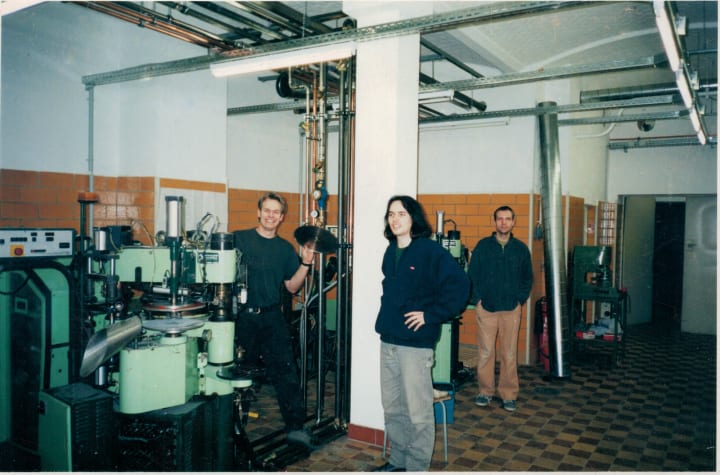
Even with a fully functional machine, the young entrepreneurs still faced two formidable challenges: finding a suitable location in Leipzig for a vinyl pressing plant and securing the funds to launch the enterprise. Given that vinyl was perceived to be a dying medium in the late ‘90s, banks weren’t exactly keen to loan them money to start their pressing plant. Nevertheless, their dogged optimism remained intact. “The first years were a rather challenging time,” Freund said. “We all had to live at our parents’ houses, and there were a couple of years when we couldn’t afford health insurance. But we were fueled by the belief that the tide would turn eventually.”
Eventually they were able to get the mastering and vinyl-cutting studio up and running with Dornberger at the helm while the rest of the plant was being constructed. Although they wanted to buy the necessary technology to assemble a cutting-edge mastering studio, their biggest priority was to get the equipment they’d need to open and operate their pressing plant. As a result, they couldn’t invest as much as they wanted to in the mastering studio. “In that regard, we were always two steps behind Dubplates & Mastering,” Dornberger said. In the meantime, R.A.N.D. started to build a customer base. They took care of the cut and then sent the lacquers to MPO and Pallas, two pressing facilities in France and northern Germany, respectively.
About 18 months after their initial trip to Sofia, R.A.N.D. was finally ready to fire up their press in 1999. “At some point we said, ‘Let’s start,’” Dornberger said. “We ordered fresh vinyl acetates and switched on the machines.” One of their first clients to take advantage of their full service was a new label out of Amsterdam called Rush Hour Records. 18 years later, Rush Hour is a famous store and label and distributor and they still work with R.A.N.D.. And over the years, R.A.N.D. made a name for itself, too.
“I think taking on the whole process of vinyl manufacturing was a bit of a generational thing,” said Freund. “It simply had to happen. The groundwork was there and it was only a matter of time until someone would get active. It definitely was worth it.”
PART THREE: CONCLUSION
When D&M and R.A.N.D. launched in the 1990s, they laid the groundwork for a niche market in Germany that catered primarily to those interested in club music. Their efforts came just at the beginning of what has proved to be a tumultuous period of transformation for vinyl manufacturing. Over the past 20 years, people have warned of vinyl’s imminent extinction many times over. Electronic dance music and hip-hop kept the industry afloat during this period, until a thoroughly unexpected and renewed interest in vinyl resulted in increased sales. Suddenly, vinyl was trendy again.
Major labels soon came rushing back to their old business model. So while more independent labels cropped up, the majors remained the driving force behind the boom with reissues of old classics in pop, rock, classical and beyond. This resurgence has led to various complications—especially for underground and independent imprints, many of which produce club music to serve a small but growing number of vinyl DJs. The demand for vinyl has outstripped the existing infrastructure for its production, such as R.A.N.D. and, to a lesser extent, D&M. Label proprietors must now compete to get slots at mastering studios and overloaded pressing plants.
Grote-Beverborg is pretty skeptical of this turn of events. “The majors tried to kill vinyl as a medium once already with the CD,” he said. “And now they are kinda doing it again with the sheer amount of reissues that are clogging the market and result in heinous waiting times.”
According to the D&M owner, there are three reasons why he thinks the ongoing vinyl hype may have a residual negative effect after it’s over. First, the waiting times may prove too painful for D&M’s core customer base in the long run, so they might skip vinyl and release only digitally. Second, pressing quality is deteriorating, which isn’t exactly a good argument for vinyl in the age of high-resolution digital audio. And third, the way the majors are going about issuing rereleases emphasizes quantity over quality. “The focus is mainly on luxurious packaging and added gimmicks, while the actual records are produced by cutting corners in regard to sourcing the best masters and the pressing itself,” Grote-Beverborg said.
Jan Freund from R.A.N.D. is more optimistic. Yes, the plant’s clients must wait longer to get their orders completed, and a lot of small labels have run into problems because of that. But there are a number of new pressing plants catering to the underground electronic music scene to alleviate this process. And this time they are in the position to help out with know-how and more. “Look at intakt!, Berlin’s newest vinyl manufacturing facility, that just opened a while ago,” he mused. “We’ve been in contact with them and even sold them a few spare parts they needed. There is a necessity for new plants like this. And just like us back in the day, they’ve taken matters in their own hands.”
Read more: An oral history of Berlin’s epic dub and bass party, Wax Treatment
Published November 10, 2017.

